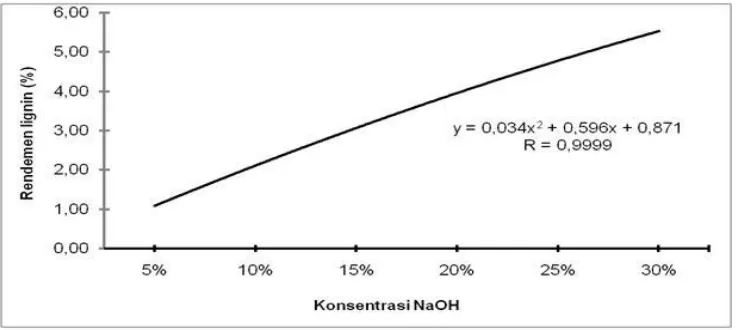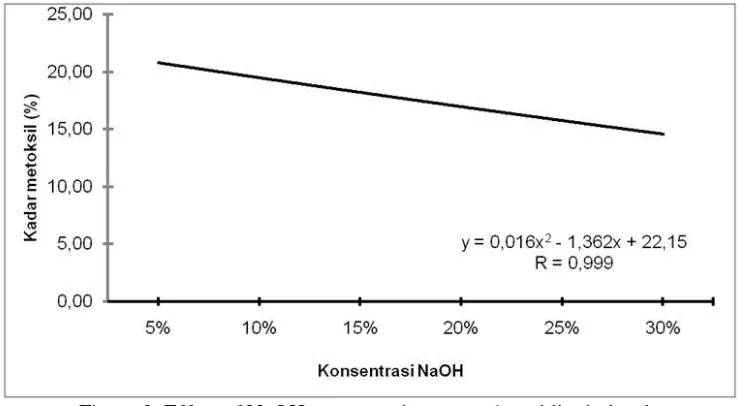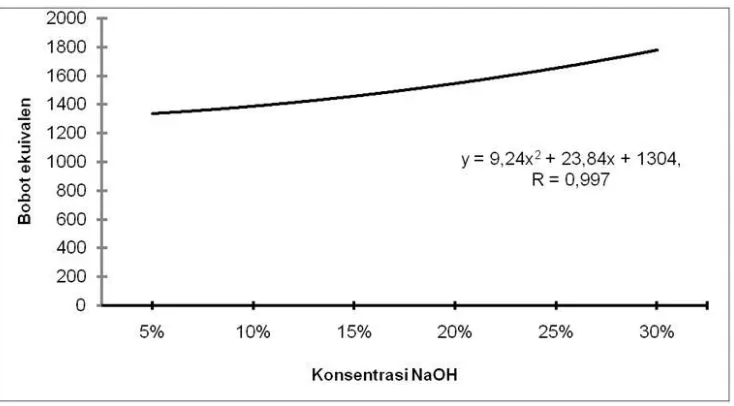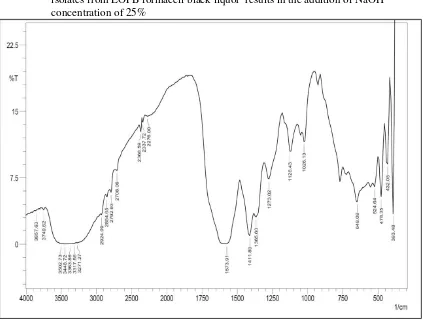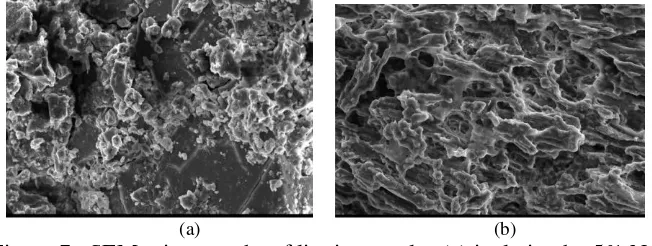IOP Conference Series: Materials Science and Engineering
PAPER • OPEN ACCESS
Isolation and characterization of formacell Lignins
from oil empty fruits bunches
To cite this article: S Hidayati et al 2018 IOP Conf. Ser.: Mater. Sci. Eng. 344 012006
View the article online for updates and enhancements.
Related content
Cellulose nanofiber isolation from palm oil Empty Fruit Bunches (EFB) through strong acid hydrolysis
Dwi Setyaningsih, Uju, Neli Muna et al.
-Preparation and Characterization of Cellulose Microcrystalline (MCC) from Fiber of Empty Fruit Bunch Palm Oil
H Nasution, Yurnaliza, Veronicha et al.
-Electricity generation from palm oil tree empty fruit bunch (EFB) using dual chamber microbial fuel cell (MFC)
N F Ghazali, N A B N Mahmood, K A Ibrahim et al.
-1234567890‘’“”
3rd IC-STAR 2017 IOP Publishing
IOP Conf. Series: Materials Science and Engineering 344 (2018) 012006 doi:10.1088/1757-899X/344/1/012006
Isolation and characterization of formacell Lignins
from oil empty fruits bunches
S Hidayati1,*, A S Zuidar1, W Satyajaya1, Murhadi1, and D Retnowati1 Department of Agro-industrial Technology, Universitas Lampung
Jl. Prof. Soemantri Brojonegoro Street, No. 1 Bandar Lampung, Lampung, 35145 Indonesia
E-mail: [email protected]
Abstract. Lignin is the largest component in black liquor, it is about 46% of solids total and can be isolated by precipitation using acid and base method. The purpose of this study was to get the best NaOH concentration to produce lignin with yield, solids total content, metoxyle lignins content, weights equivalent of lignin in the black liquor by pulping formacell process from oil empty fruits bunches. This study was done with isolation lignin process in black liquor used by NaOH concentration were 5%, 10%, 15%, 20%, 25%, and 30% from volume black liquor and then precipitationed for 10 hours. The result of this research showed the isolation of lignin with NaOH concentration 30% get the pH 5,42%, yield of lignin was 5,67%, solids black liquor total was 65,11%, levels of metoxyle lignin 14,61%, and equivalent weights of lignin was 1787,23. The result of FT-IR identifications of isolates lignin in NaOH concentration 25 and 30% showed a pattern infiltration spektro IR that almost a part that have the same infiltration at the wave numbers that showed lignin had one of the rings lignin was guaiasil, it was building blocks of non wood lignin.
1. Introduction
1234567890‘’“”
3rd IC-STAR 2017 IOP Publishing
IOP Conf. Series: Materials Science and Engineering 344 (2018) 012006 doi:10.1088/1757-899X/344/1/012006
liquor also contains aliphatic acids, acids, resins and polysaccharides increase the burden of oxygen demand in water. Component of black liquor is lignin which is about 46% of its total solid [3], therefore isolation and separation of lignin is more likely. Black liquor can be a source of lignin feedstock[1][4] [5] [6][7][8][9]. Lignin structure and physico chemical properties depends on isolation method and raw material source [10][11]. Black liquor can be isolated alkaline method or acid method to obtain pure lignin. The research trend is an attempt to harness lignin into more useful chemicals [12]. Commercial use of lignin maybe used carbon fiber, adhesive, polyurethane, polyester, bioplastic, and bio oil for petroleum mixtures of fossils [5,9,13,14,15]. The presence of phenolic ring inside lignin can be utilized for phenolic formaldehyde resins [4,5,6,7,16]. Beside lignin can be used as a filler and reinforcing phases for polymer blends [17,18,19,20,21,22]. The advantage of lignin is to have a high number hidroxyl group can be used for the production of polyol and either through direct utilization or after chemical modification for the production of certain polymers such as polyurethane [23,24,25].
In the world it is attempting to utilize black liquor as a source of lignin feedstock. Some lignin isolation methods include: 1). Klason Method; 2). The Björkman method is also called "Milled Wood Lignin / MWL"; 3). CEL Method, Cellulolythic Enzyme Lignin or "lignin of cellulolytic enzymes"; 4). Technical Lignin Isolation Method, namely the lignin isolation method of residual pulp liquor. The process of lignin isolation from black liquor can use acids such as H2SO4, phosphoric acid (H3PO4), or
HCl [26, 27]. While the basic method can use bases such as NaOH and KOH [28]. In this step about 75% of the lignin is precipitated as the sodium salt. Finally, lignin is separated through a screening process Lignin hydrolysis contains solid lignin residues and large amounts of unhydrolyzed cellulose [27].
The characterization of softwoods and hardwoods black liquor from the pulping of non-wood fibers such as reed canary grass, sugarcane baggasse, wheat straw have been investigated lately. However, none works had been done on the black liquor from black liquor formacell EOFB pulping process. Formacell is one of the organosolved pulping methods that use acetic acid and formic acid as cooking solution [29,30,31,32]. The pressure and temperature can be lower when formic acid is used in pulping compared to those used in alcohol or acetic acid pulping. The advantage of organic acid lignin is an optimal feedstock for many value-added products, due to its lower molecular weight and higher reactivity and organic acid pulping is the retention of silica on the pulp fiber that facilitates the efficient recovery of cooking chemicals.
1234567890‘’“”
3rd IC-STAR 2017 IOP Publishing
IOP Conf. Series: Materials Science and Engineering 344 (2018) 012006 doi:10.1088/1757-899X/344/1/012006
2. Methodology 2.1.Raw material
The materials used in this research are black liquor from EOFB formacell pulping, NaCl, NaOH, HCl, water, aquades, ethanol, KBr, filter paper, phenolpthalin indicator, aluminum foil, and clip. The tools used in this research are acid cabinet, acid stove, aluminum cup, digital scales, porcelain cup, oven, desiccator, beaker glass, erlenmeyer, pH meter, dropper drop, volume pipette, stirrer, measuring cup, Funnel, centrifuge, stirrer, titration device and FT-IR (Fourier Transform Infra-Red Spectroscopy) spectrophotometer and SEM (Scanning Electron Microscopy)
2.2.Research methods
This research begins with the process of purifying liquid waste from pulp filtration (black liquor) by using lignin isolation method which refers to isolation method developed by Lubis [35] as shown in Figure 1. A total of 100 ml of filtered black liquor (filtrate) Precipitated lignin by stirring and adding by NaOH with concentrations of 5%, 10%, 15%, 20%, 25%, and 30% (percent v / v) of black liquor volume which then homogenized using a stirrer. Stirring process is done slowly then measured pH of each treatment, then subsequently settled for 10 hours for perfect deposition. The lignin deposit is separated from black liquor using centrifuge (2500 rpm, 20 min). The observations were: pH value, total solids content in black leachate EOFB, lignin yield, lignin methoxyl content, lignin equivalent weight, and lignin analysis with FT-IR spectrophotometer and Scanning electron microscopy (SEM) has been most useful technique for quantification of lignin structural details.
1234567890‘’“”
3rd IC-STAR 2017 IOP Publishing
IOP Conf. Series: Materials Science and Engineering 344 (2018) 012006 doi:10.1088/1757-899X/344/1/012006
3. Results and discussion 3.1. Yield of Lignin
The yield was also found to increase for black liquor with a higher total dry solid (TDS) content. The average value of lignin isolate content from various concentrations ranged from 1.48% - 5.67% (Figure 2). The result of variance analysis showed that the NaOH concentration teatment had highly significant effect on yield of lignin.
Figure 2. Effect of NaOH concentration on lignin yield
1234567890‘’“”
3rd IC-STAR 2017 IOP Publishing
IOP Conf. Series: Materials Science and Engineering 344 (2018) 012006 doi:10.1088/1757-899X/344/1/012006
precipitate was obtained at an average pH of 5.42 with a 30% NaOH concentration. Increasing the concentration of NaOH results in an increase in pH value due to the addition of base or high alkalinity of the substance increases many OH-ions in water. The greater the pH value of a substance the stronger the degree of base The strength of base can be determined from the scale of basicity which is also expressed by pH value [28].
3.2. Lignin Methoxyl Levels
Methoxyl lignin content in this study has an average value ranges between 14.61 - 20.77% (Figure 3). The result of variance analysis showed that the NaOH concentration treatment had very significant effect on lignin methoxyl content.
Figure 3. Effect of NaOH concentration on methoxyl lignin levels
The highest levels of methoxyl lignin are present in the addition of 5% NaOH concentration with an average of 20.77%. While the lowest methoxyl lignin levels were found in the addition of 30% NaOH concentration with an average of 14.61%. In general, high methoxyl levels will inhibit lignin reactivity during resin use. Lignin contains phenolic hydroxyl groups which are mostly bonded with adjacent propane phenyl units, allowing the occurrence of lignin bonds with formaldehyde similar to those of a reaction between phenol and formaldehyde [43]. However, in its use as a raw material of lignosulfonate (surfactant), lignin with high methoxyl content is more advantageous because the more -OCH 3 groups contained in lignin, the lignin is increasingly dissolved in water. Such properties are indispensable to lignosulfonate feedstocks.
Meanwhile, low methoxyl levels are suspected because some of the methoxyl groups are degraded and turned into other compounds due to the overuse of acid or base. In alkaline process,
1234567890‘’“”
3rd IC-STAR 2017 IOP Publishing
IOP Conf. Series: Materials Science and Engineering 344 (2018) 012006 doi:10.1088/1757-899X/344/1/012006
[44]. According to Fengel and Wegener [45], this low metoxyl value is probably caused by the influence of harsh chemicals during isolation, causing the lignin structure to undergo many changes. Low lignin methoxyl levels can be utilized in their use as an adhesive, lignin with a lower methoxyl content is more advantageous than high methoxyl levels, since lignin with low methoxyl content is easier to form gel [46].
3.3. Lignin's Equivalent Weight
The average value of the lignin equivalent weight ranges from 1327.64 - 1787.23 (Figure 4). The result of variance analysis showed that the NaOH concentration treatment had very significant effect on the weight of lignin equivalent.
Figure 4. Effect of NaOH concentration on lignin equivalent weight level
1234567890‘’“”
3rd IC-STAR 2017 IOP Publishing
IOP Conf. Series: Materials Science and Engineering 344 (2018) 012006 doi:10.1088/1757-899X/344/1/012006
of lignin increases with decreasing pH and temperature and/or with increasing ion strength of kraft black liquor used. The concentration of carbohydrates in lignin decreases with decreasing pH or with increasing temperature, and that an increasing amount of lower molecular weight lignin is precipitated at a higher precipitation yield. This principle is similar to the lignin isolation process using NaOH . According to Santoso [48], the distribution of molecular weight of lignin varies greatly. Lignin is a very complex organic compound, composed of a number of highly variable constituent components, it is difficult to obtain definite molecular weights. By means of chromatographic separation obtained data of lignin molecule weights range of 370-44300 [49]. b. While the results of research [48] states the molecular weight of lignin isolates from black liquor ranged from 304-4010. Based on the equivalent weight obtained in this study, it meets the criteria based on according to Connors et al. [49] and Santoso [48].
3.4. Lignin Analysis with FT-IR Spectrophotometer
1234567890‘’“”
3rd IC-STAR 2017 IOP Publishing
IOP Conf. Series: Materials Science and Engineering 344 (2018) 012006 doi:10.1088/1757-899X/344/1/012006
Figure 5. Results of identification with FT-IR spectrophotometer on lignin isolates from EOFB formacell black liquor results in the addition of NaOH concentration of 25%
Figure 6. Results of identification with FT-IR spectrophotometer on lignin isolates from EOFB formacell black liquor results in addition of 30% NaOH concentration
Table 1. Fourier transform infrared of two lignin samples [41,50]
No Lignin
isolate
Lignin isolate
Indulin-AT
Band Posision
Asignment
NaOH
25%
NaOH 30%
(cm-1)*)
1 3441.01 3411.36 3450-3400 OH stretch
2 2846.93 2936.36 2940-2820 OH strain on the methyl and methylene groups
1234567890‘’“”
3rd IC-STAR 2017 IOP Publishing
IOP Conf. Series: Materials Science and Engineering 344 (2018) 012006 doi:10.1088/1757-899X/344/1/012006
with an aromatic ring
4 - 1668.18 1675-1660 The C = O range is unconjugated with an aromatic ring
5 - 1602.27 1605-1600 Vibration of aromatic rings 6 1589.35 1573.91 1595 Aromatic sceletal vibration, C=O
stetching (conjugated) 7 - 1511.36 1515-1505 Vibration of aromatic rings
8 - 1465.91 1470-1460 C-H deformation (asymmetry
9 - 1427.27 1430-1425 Vibration of aromatic rings
10 1365.60 1365.91 1370-1365 In-plane deformation vibration of phenolic OH
11 - - 1330-1325 Vibration of siringyl ring
12 1273 1273.03 1270.45 1270-1275 Vibration of guaiacyl rings 13 - 1031.82 1085-1030 Deformation of C-H and C-O 14 1026.13 1026.13 1030 C-O of syringyl and guaiacyl
ring, C-H bond in guaiacyl ring
The best isolation conditions were lignin isolates with 25% and 30% NaOH concentrations. The lignin isolates were compared with the standard lignin used ie lignin indulin-AT. The purpose of the functional group analysis is to know the functional groups present in lignin from the isolated and standard lignin products used. The two bands at 2900 cm-1 and 2800 cm-1 correspond to methyl
(−CH3) and methylene (−CH2) groups. The phenolic OH groups in lignin (band at 1365 cm-1), are
produced during chemical process when β-O-4 linkages are cleaved and generate non-etherified hydroxyls. Low intensity of this band in NaOH 30% spectrum shows that small portion of phenolic
OH group is generated (due to less β-O-4 linkage cleavage). The intensity of absorption bands at 1268 cm-1 (C-O stretching of guaiacyl ring) spectra is stronger than other lignins because guaiacyl is dominant lignin unit in EOFB. The absorption band range 1030-1025 cm-1 is assigned to deformation
vibration of C−H bonds in the guaiacyl ring and also assigned to C-O bonds in both syringyl and guaiacyl [41]. Bands at 1330-1325 cm-1 were attributed to syringil with C-O stretching. Bands at 1217 cm-1 for OPEFB can be attribute to phenolic OH and ether in syringil and guaiacyl [52]. The bands observed at 1030-620 cm-1 were attributed to hemicelluloses and silicates contribution [51].
1234567890‘’“”
3rd IC-STAR 2017 IOP Publishing
IOP Conf. Series: Materials Science and Engineering 344 (2018) 012006 doi:10.1088/1757-899X/344/1/012006
lignin isolates resulting from black liquor of this organosolve delignification process with a 30% NaOH concentration suggests the presence of one of the lignin ligands, ie guaiasil which are the units Lignin constituents in non-wood lignin.
3.5. Assessment of the structure of OPFEB formacell lignin
The Scaniing Electrom Miscoscope (SEM) studies revealed the details on structural and marfologies of lignin. Lignin was analyzed by using SEM that is lignin with treatment of NaOH concentration that is 5% and 30% (Figure 7).
The result of SEM analysis showed that lignin isolation treatment using 30% NaOH concentration had a more compact form of agglomeration compared with isolation using 5% NaOH. At the high pH of typical kraft black liquof, the repulsive forces between the ionized hydrophilic groups (mainly phenolic hydroxyl and carboxylate groups) stabilize the colloidal lignin and keep it in solution, thereby preventing lignin agglomeration and precipitation [56]. The results of Namane et al [57] showed that the lignin isolation process from liquor derived from formacell produces a constant granular structure.
4. Conclusion
The best lignin isolates were on lignin deposition with 30% NaOH concentration by total solids content in EOFB black liquor, lignin of yield, lignin methoxyl content, lignin equivalent weight, The average lignin yield is 5.67%, the total solid black liquor with an average of 65.11%, the lignin methoxyl content with an average of 14.61% and the weight of the lignin equivalent with an average of 1787.23.. The result of FT-IR identification from lignin isolate at 30% NaOH concentration shows IR spectral absorption pattern which almost most have the same absorption pattern at wave number region. Isolates of lignin at a 30% NaOH concentration showed that lignin has one lignin ring ie guaiasil which is lignin composing units in non-wood lignin.
Acknowledgment
(a) (b)
1234567890‘’“”
3rd IC-STAR 2017 IOP Publishing
IOP Conf. Series: Materials Science and Engineering 344 (2018) 012006 doi:10.1088/1757-899X/344/1/012006
This research work was supported by Fundamental Research Grant 2017, No. 071/SP2LH/LT/DRPM/IV/2017. The authors would also like to acknowledge the contributions and financial support from Ministry of Research, Technology, and Higher Education of the Republic of Indonesia.
References
[1] Zhang AP, Liu CF, Sun RC and Xie J 2013 Extraction, purification and characterization of lignin fractions from sugarcane bagasse Bioesources. 8 (2): 1604-1641
[2] Louhelainen J, Alen R, Zielinsk I J, and Sagfors P E 2002 Effects of oxidative and non -oxidative thermal treatments on the viscosity and chemical composition of softwood kraft black liquor J of Pulp and Paper Science 28(9), 285 -291
[3] Sjostrom E 1981 Wood Chemistry, Fundamentals and Applications, Academic Press, New York, 223 p
[4] Abdelwahab N, Nassar M 2011 Preparation, optimisation and characterisation of lignin phenol formaldehyde resin as wood adhesive Pigment & Resin Technology 40, 169-174
[5] Alonso MV, Oliet M, P Rez, Rodriguez F, Echeverra J 2004 Determination of curing kinetic parameters of lignin–phenol–formaldehyde resol resins by several dynamic differential scanning calorimetry methods. Thermochimica Acta 419, 161-167
[6] Khan MA, Ashraf SM, Malhotra VP 2004 Eucalyptus bark lignin substituted phenol formaldehyde adhesives: A study on optimization of reaction parameters and characterization. J of Applied Polymer Science 92, 3514-3523
[7] Mankar S, Chaudhari A, Soni I 2012 Lignin in phenol-formaldehyde adhesives International J of Knowledge Engineering 3, 116-118
[8] Sarkar S, Adhikar B 2001 Jute felt composite from lignin modified phenolic resin. Polymer Composites 22, 518-527.
[9] Tejado A, Pena C, Labidi J, Echeverria J M and I Mondragon 2007 Physico-chemical characterization of lignins from different sources for use in phenol-formaldehyde resin synthesis Bioresource Technol. 98: 1655-1663
[10] Bykov I 2008 Characterization of Natural and Technical Lignins using FTIR Spectroscopy. PhD thesis, Lulea University of Technology
[11] Sahoo S, Seydibeyoğlu MÖ, Mohanty AK, and Misra M 2011 Characterization of industrial lignins for their utilization in future value added applications. Biomass and Bioenergy 35, 4230-4237
[12] Anglès MN, Reguant J, Garcia-Valls R and Salvadó J 2003 Characteristics of lignin obtained from steam-exploded softwood with soda/anthraquinone pulping Wood Science and Technology 37, 309-320
[13] Bonini C, M Auria, L Emmanuel, R Ferri, R Pucciarello and AR Sabia 2005 Polyutrethanes and Polyester from Lignin J Applied Polymer Science, 98 (3): 1451-1456
[14] Kleinert M, and T Barth 2008 Towards in Lignicellulosic Biorefinery: Direct One Step Conversion of Lignin to Hydrogen-Enriched Biofuel Energy Fuels. 22 (2): 1371-1379 [15] Xu F, Sun J-X, Sun R, Fowler P and Baird M.S 2006 Comparative study of organosolv lignins
1234567890‘’“”
3rd IC-STAR 2017 IOP Publishing
IOP Conf. Series: Materials Science and Engineering 344 (2018) 012006 doi:10.1088/1757-899X/344/1/012006
[16] Cheng S, Yuan Z, Leitch M, Anderson M, Xu C 2013 Highly efficient de-polymerization of organosolv lignin using a catalytic hydrothermal process and production of phenolic resins/adhesives with the depolymerized lignin as a substitute for phenol at a high substitution ratio Industrial Crops and Products 44, 315-322
[17] Cazacu G, Pascu M.C, Profire L, Kowarski A I, Mihaes M, Vasile C 2004 Lignin role in a complex polyolefin blend. Industrial Crops and Products, 20, 261-273
[18] Gosselink R J A, Abächerli A, Semke H, Malherbe R, Käuper P, Nadif A and Van Dam J E G 2004 Analytical protocols for characterisation of sulphur-free lignin. Ind. Crop. Prod. 19, 271–281
[19] Hatakeyama H, Nakayachi A and Hatakeyama T 2005 Thermal and mechanical properties of polyurethane-based geocomposites derived from lignin and molasses Composites Part A: Applied Science and Manufacturing 36, 698-704
[20] Kadla J F, Kubo S, Venditti R A, and Gilbert R D 2002 Novel hollow core fibers prepared from lignin polypropylene blends. J. Appl. Polym. Sci. 85, 1353–1355
[21] Lora J H, Glasser W G, 2002. Recent industrial applications of lignin: A sustainable alternative to nonrenewable materials. J. Polym. Environ. 10, 39-48
[22] Schorr D, Diouf PN, and Stevanovic T 2014 Evaluation of industrial lignins for biocomposites production. Industrial Crops and Products 52, 65-73
[23] Cateto C A, Barreiro, M F, Rodrigues AE, Brochier-Solan M C, Thielemans W and Belgacem M N 2008 . Lignins as macromonomers for polyurethane synthesis: A comparative study on hydroxyl group determination. J of Applied Polymer Science 109, 3008-3017
[24] Huang J, Zhang L 2002 Effects of NCO/OH molar ratio on structure and properties of graft-interpenetrating polymer networks from polyurethane and nitrolignin. Polymer 43, 2287-2294.
[25] Mahmood N, Yuan Z, Schmidt J, and Xu C 2013 Production of polyols via direct hydrolysis of kraft lignin: Effect of process parameters. Bioresource Technology 139, 13-20
[26] Li J 2011 Isolation of lignin from wood, BSc thesis, Faculty of Technology. SAIMAA University of applied science, USA
[27] Vishtal A and Kraslawski A 2011 Challenges in industrial applications of technical lignins. BioRes. 6, 3547–3568
[28] Setyawardhani D A 2014 Practical Guidelines for Quantitative Chemistry Analysis. Surakarta [29] Poppius, Levlin K, Mustonen R, Huovila T, and Sundquist J 1991 Milox pulping with acetic –
acid . paperi ja Puu-Paper Timber., 73(2): 154-158
[30] Jimenez L, F Maestre, J L Ferrer and I Pérez 1998 Delignification of wheat straw by use of low-molecularweight organic acids. Holzforschung 52 (2):191–196
[31] Lam H Q, Bigot Y L, Delmas M, and Avigon G 2001 Formic acid pulping of rice straw. Ind. Crops Prod., 14(1): 65-71
[32] Hidayati S, Zuidar A S and Satyajaya W 2017 Effect Of Acetic Acid: Formic Acid Ratio On Characteristics Of Pulp From Oil Palm Empty Fruit Bunches (OPEFB). ARPN J of
1234567890‘’“”
3rd IC-STAR 2017 IOP Publishing
IOP Conf. Series: Materials Science and Engineering 344 (2018) 012006 doi:10.1088/1757-899X/344/1/012006
[33] Sun R R, Tomkinson J J and Lloyd Jones GG 2000 Fractional characterization of ash-AQ lignin by successive extraction with organic solvents from oil palm EFB fibre. Polymer
Degradation and Stability 68, 111-119
[34] Cheng S 2011 Bio-Based Phenolic Resins And Adhesives Derived From Forestry
Residues/Wastes And Lignin. Disertation. Faculty of Natural Resources Management Lakehead University Thunder Bay, Ontario, Canada
[35] Lubis A A 2007 Lignin Isolation from Black Linde (Black Liquor) Pulp Cooking Process Soda and Pulp Sulphate (Kraft). (Essay). Bogor Agricultural Institute. Bogor. 81 p
[36] Sundin J 2000 Precipitation of kraft lignin under alkaline conditions. Ph.D thesis, Royal Institute of Technology, Stockholm, Sweden
[37] Vainio U, Maximova N, Hortling B, Laine J , Stenius P, Simola L. K, Gravitis J and Serimaa R 2004 Morphology of Dry Lignins and Size and Shape of Dissolved Kraft Lignin Particles by X-ray Scattering. Langmui. 20 9736-9744
[38] Vasileva T S, Nenkova and K. Stanulov 2007 Obtaining of Phenolic Compounds through Alkaline Depolymer-ization of Technical Hydrolysis Lignin, Cellulose Chem. Technol 41, 7-8:379-384
[39] Heradewi 2007 Lignin Isolation from Black Leafy Process of Organosolv Bunching of Cluster Fibers Empty Palm Oil (EOFB). Essay Bogor Agricultural Institute. Bogor. 109 p
[40] Theliander, H 2010 The LignoBoost process: Solubility of lignin. International Chemical Recovery Conference 29th March - 1st April 2010 Williamsburg, VA, USA. 33-42.
[41] Zhu W 2013 Equilibrium of Lignin Precipitation The Effects of pH, Temperature, Ion Strength and Wood Origins. THESIS. Forest Products and Chemical Engineering Department of Chemical and Biological Engineering Chalmers University Of Technology Gothenburg, Swede
[42] Lin S Y and W D Carlton 1992 Methods in Lignin Chemistry Berlin Heidelberg: Springer-Verlag. 69: 627-642
[43] Syahmani 2000 Isolation, Sulfonation and Lignin Acetylation of Oil Palm Bunches and Studies Its effect on Urea Dissolution Process. Thesis Faculty of Mathematics and Science, Bandung Institute of Technology. Bandung
[44] Kirk R E and D F Othmer 1952 Encyclopedia of Chemical Technology. Vol.3. The Interscience Encyclopedia, Inc., New York Pp.327-338
[45] Fengel and G Wegener 1984 Wood: Chemistry, Ultrastructure, Reactions de Gruyter, Berlin, Pp. 1-729. X111, 613 S
[46] Damat 1989 Isolation of Lignin from Cooking Solution by Pulp Factory Using H2SO4 and HCl. Essay). Department of Agricultural Industrial Technology, Faculty of Agricultural
Technology, Bogor Agricultural University Bogor 3 p
[47] Casey P J 1952 Pulp and Paper, Chemistry and Chemical Technology Vol. 1: Pulping and Paper Making. The Wiley Intersince Publisher, Inc., New York
1234567890‘’“”
3rd IC-STAR 2017 IOP Publishing
IOP Conf. Series: Materials Science and Engineering 344 (2018) 012006 doi:10.1088/1757-899X/344/1/012006
[49] Connors W J, L F Lorenz and T K Kirk 1978 Chromatographic Separation of Lignin Models by Molecular Weight using Sepandhex LH-20. Holzforschung 31
[50] Hergert H L 1971 Infrared Spectra Willey Interscience, New York 267-297
[51] Garcia, A. A. Toledano, L. Serrano, I. Egues, M. Gonzalez, F. Marin, and J. Labidi 2009
“Characterization of lignin obatain by selective precipitation”, Separation and Purification Technology, 68, pp. 193-198
[52] Lubis M A R, A R Dewi , L Risantoa, LH Zaini, E Hermiatia 2012 . Isolation and
Characterization of Lignin from Alkaline Pretreatment Black Liquor of Oil Palm Empty Fruit Bunch and Sugarcane Bagasse. Mechatronics, Electrical Power, and Vehicular Technology
XX . XX-XX 2. 1-5 p.
[53] Higuchi T 1997 Biochemistry and Molecular Biology of Wood. Springer-Verlag, London [54] Boerjan W, Ralph J, Baucher M 2003 Lignin biosynthesis. Annu Rev Jornal of Plant Biology
54: 519–546
[55] Ralph SA, Ralph J, Landucci L 2004 NMR Database of Lignin and Cell-Wall Model Compounds. U.S. Forest Products Laboratory, Madison,
WI:http://ars.usda.gov/Services/docs.htm?docid=10491 (July 3, 2006)
[56] Hermans, M. A 1984 High intensity black liquor oxidation, PhD. Thesis, Law rence University, [57] Namane,M; García-Mateos F.J., Sithole, B; Ramjugernath, D; Rodríguez-Mirasol, J And
![Figure 1. The modified lignin isolation diagram [35]](https://thumb-ap.123doks.com/thumbv2/123dok/3994507.1937927/4.595.188.409.381.620/figure-modified-lignin-isolation-diagram.webp)
